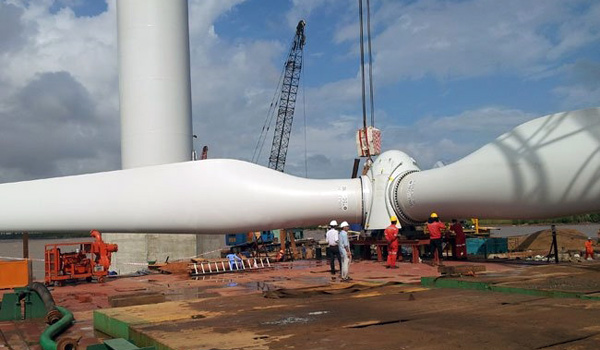Vietnam has substantial potential for wind energy and it’s hoped that it will play an increasingly larger role in turning the country away from dependence on fossil fuels, said leading economist Pham Chi Lan. Speaking at a recent conference in Hanoi, Ms Lan argued that the national plan for meeting future energy, which calls for 60% of electrical energy to be generated from coal by 2030, places too much reliance on dirty fossil fuels.
For one reason, the country must move to cleaner renewable sources of power such as wind, she cautioned. And for a second, such high dependence on coal would require substantial imports and leave the country overly dependent on overseas markets for electrical energy.
To incentivize the movement away from the development of energy from fossil fuels such as coal and oil the government introduced a feed-in tariff tax benefit scheme six years ago that ultimately proved unappealing to investors.
Despite a range of tax benefits offered to foreign investors by the scheme that included exemptions from customs duties, a preferential corporate tax rate of 10% and income tax and land use fee exemptions, the government ultimately was forced to revise their plan for wind energy downwards.
The revised plan targeted 6.5% of the country’s electricity demand coming from renewables by 2020 and 10.7% by 2030. For wind specifically, the goal was 800 MW by 2020, 2,000 MW by 2025 and 6,000 MW by 2030.
These lower targets, if achieved, would account for just 0.8% of total electricity production in 2020, 1% in 2025 and 2.1% in 2030 originating from wind.
Winds of change
Nguy Thi Khanh, director of the Green Innovation Center, in turn agreed that the potential for wind energy in Vietnam, with its 3,000km of coastline that is subject to regular monsoonal winds, is a great alternative to coal if the country can raise the funds needed to invest in the technology to harness it.
Mr Khanh agreed with Ms Lan that although coal could provide enough energy, it would result in too much dependence on imports to meet the country’s basic electrical demand while concomitantly resulting in too many environmental problems.
According to a World Bank report, other speakers noted, 8.6% of the land mass of Vietnam is suitable for the construction of wind farms, which is sufficient to meet an extensive portion of its current and future electrical needs.
The waters of the East Sea bordering the southern tip of the country have an average wind speed at sea of 10-11km per hour, according to research conducted by the Vietnam Institute of Seas and Islands.
Wind turbines placed at a height of 80 metres above sea level could generate 400-800W per square metre per year.
These speakers underscored the fact that there is strong interest in the country’s energy segment from both foreign and domestic sector investors, but the current low sales price of energy to consumers is the chief obstacle stemming the flow of investment dollars.
According to a United Nations Development Program report, the current tax benefits from the feed-in tariff tax benefit scheme put in place six years ago are inadequate in that— even with the benefits investors are not even able to break even and recover their initial capital outlay.
Blown off course
The low price charged consumers for electrical power has blown the development of wind energy in Vietnam off course.
Ultimately, to make renewable energy feasible and attractive to investors the prices charged to consumers must increase or the government must step in and heavily subsidize the projects, raising the funds needed through higher taxes.
It’s a complex problem that involves national and provincial laws and regulations that can lead to many contradictory interpretations of proposed legislation and their application that isn’t beneficial to attracting investment.
Experts also noted that a study by the German Agency of International Cooperation indicated that the prices for energy would need to be raised to US$0.098/kWh for mainland farms and US$0.112/kWh for offshore projects to make wind renewable energy projects financially and commercially viable.
Too good to miss
However, even as foreign investors wait for news on increased pricing from governmental authorities, some deals are already moving forward on the assumption that positive changes will be instituted by the Vietnam national and provincial governments.
A massive 800 MW Vietnamese Phu Cuong Wind Farm has been officially formalized under a US$2 billion Joint Development Agreement between GE Renewable Energy, Mainstream Renewable Power, and local Vietnamese partner, the Phu Cuong Group.
Mainstream is also currently planning two other projects in the southern province of Binh Thuan that have the potential to produce a combined capacity of 138 MW.
Most certainly, deals like these don’t represent noteworthy progress but at least demonstrate that the country is on a path that ultimately will lead to harnessing the full potential of wind power and getting the wind turbines spinning in the right direction.
vietnamnet.vn



